Iran-HRM – Iran Human Rights Monitor (Iran HRM) has made an effort in its annual report to provide an overview of the human rights situation in Iran. Given that the judiciary in Iran extensively employed executions as the most ruthless and inhumane form of punishment in 2023, a significant portion of the 2023 annual report focuses on executions. Another section of the report addresses the investigation into the suppression of protesters during the nationwide protests of 2022-2023.
The Iranian regime, in an attempt to suppress the nationwide protests, targeted the protesters and sought to silence any dissenting voices. They issued death sentences, along with severe and unjust verdicts, and employed brutal forms of torture to stifle the voice of every protester.
The policy of “creating fear by using heavy punishments and issuing death sentences” has become the official policy of Iran’s judiciary, and in this regard, it has the full support of Ebrahim Raisi as the president, especially since Raisi has the experience of being a member of the Death Commission in the massacre of the summer of 1988.
Executions of 850 People
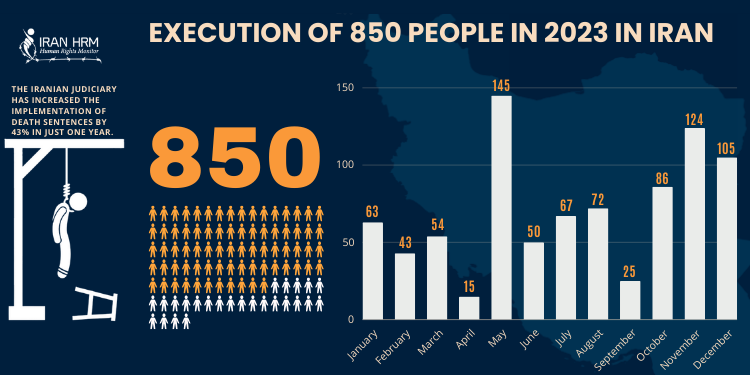
Indeed, the death penalty is considered one of the most severe forms of punishment, and it has been abolished or significantly restricted in over 170 countries worldwide. Only around 30 countries still actively use the death penalty. Unfortunately, the Iranian regime consistently remains at the forefront of these countries that continue to implement capital punishment. Julia Duchrow, the Deputy Secretary General, Amnesty International (Germany), has stated regarding executions in Iran, “The leader of Iran is responsible for 65% of the executions carried out worldwide last year.”
Critics of the executions in Iran believe that the Iranian government utilizes the death penalty as a tool to suppress opponents and instill fear and terror within society. Many human rights activists and international organizations consider the death penalty as the most inhumane and degrading form of punishment. However, despite this consensus, the number of executions in Iran reached 850 individuals in 2023. This indicates a concerning trend of high execution rates in the country.
This is happening while the Iranian regime had 578 executions in the past year, and the Iranian judiciary has increased the implementation of death sentences by 45% in just one year. The number of executions reached 850 individuals in 2023. In this annual report, we intend to explore executions in Iran in the following categories:
- Execution of political prisoners
- Execution of ordinary prisoners
- Execution of children under 18 years old
- Execution of women
- Secret Executions and Executions Carried Out in Public
Execution of political prisoners

In 2023, the number of executions of political prisoners increased significantly compared to the previous year, reaching 20 individuals. Among the executed individuals were three of the protesters from November 2019. Gholam Rasoul Heydari was the first protester to be executed on November 22, 2023. A week later, on Tuesday, November 28, 2023, Hani Shahbazi was executed, followed by Kamran Rezaei on Thursday, November 30, 2023.
Furthermore, Ali Saber Motlagh is another political prisoner from the 1980s who was detained on charges of supporting the People’s Mojahedin Organization of Iran (PMOI). In the early morning of Saturday, November 25, 2023, his death sentence was carried out based on charges attributed to him in 1981.
Ayoub Karimi and Ghassem Abesteh, both Kurdish political prisoners, were also among those executed in 2023. Ghassem Abesteh, a Kurdish political prisoner, was executed on November 5, 2023, after enduring more than a decade in prison. Similarly, Ayoub Karimi, after 14 years of imprisonment, was executed on November 29, 2023. On the last days of December 2023, four Kurdish political prisoners were executed on charges of collaborating with Israel using a hangman’s noose.
Execution of ordinary prisoners
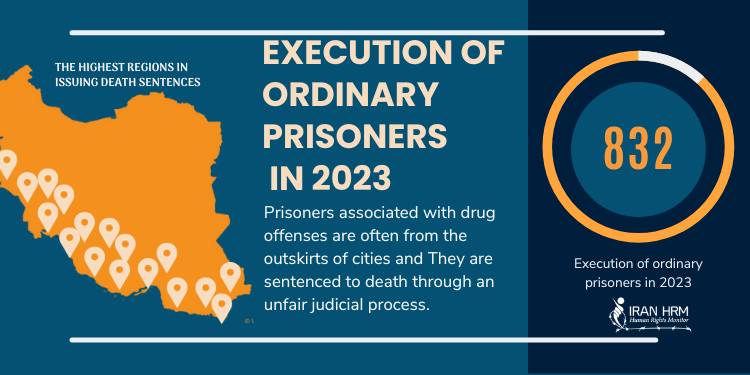
In 2023, the number of executions of ordinary prisoners reached 832 individuals. Among them, the execution of prisoners involved in drug-related crimes has increased several-fold compared to the previous year. Prisoners associated with drug offenses are often from the slums near cities and are considered to be from impoverished segments of society. They are sentenced to death through an unfair judicial process.
While crimes related to drugs should never be subject to the death penalty according to international laws, a video file was released on Wednesday, December 20, 2023, in which Yahya Ebrahimi, the representative of Delfan County in the regime’s parliament, stated: “Around one to two thousand young people from this county have been sentenced to death on charges of selling drugs,” and “they are in the stage of implementation of their verdicts.”
Such a high number of death sentences in a small county with a small population is a human rights catastrophe. This issue is not limited to Delfan County, but a pattern implemented in each and every marginalized region of Iran. Thousands of individuals across Iran are being prepared for execution solely for drug crimes, which demonstrates a targeted and premeditated crime.
Execution of children under 18 years old

Despite Iran’s accession to the Convention on the Rights of the Child in 1993, the regime continues to violate the provisions of the convention regarding the prohibition of executing individuals who committed crimes while under the age of 18. In 2023, the Iranian Judiciary executed three individuals under the age of 18.
Hamidreza Azari, a 17-year-old, was executed by hanging in Sabzevar Prison on Friday, November 24, 2023. Additionally, a Baluch teenager named Adel Damani, who was under 18 years old at the time of his arrest, was executed in Chabahar prison. Similarly, Hamid Bakshayesh, who was only 16 years old when he committed the crime, was executed on December 13, 2023. After serving 15 years in prison, this prisoner’s sentence was executed. Since 2007, he was sentenced to Qesas (retribution) on the charge of “intentional murder.”
Execution of women
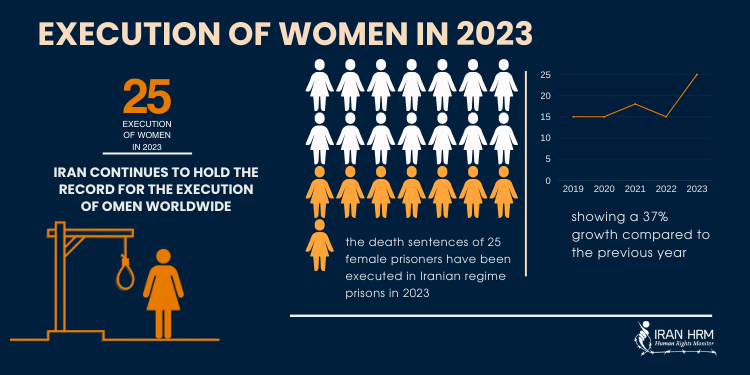
According to the statistics recorded by Iran Human Rights Monitor (Iran HRM), since January 2023, the death sentences of 25 female prisoners have been executed in Iranian regime prisons, showing a 37% growth compared to the previous year. Iran continues to hold the record for the execution of women worldwide.
Last year, Iran became the largest executioner of women in the world by executing at least 16 women in 2022. According to Amnesty International’s report in 2022, a total of 24 women were executed worldwide, 16 of which belonged to Iran.
Secret Executions and Executions Carried Out in Public

In 2023, the death sentences of 693 prisoners were carried out secretly without any media coverage. The death sentences of 126 prisoners were reported by the media. Most of the data on executions is obtained through independent media and through communication with inside the prison.
The Iranian government censors the news of executions and in this way justifies itself for not responding to the international community.
Also, by taking advantage of the war between Israel and Hamas and the focus of media attention on the situation in Gaza Strip, the government of Iran has stepped up the executions in the silence of the media. The number of executions has increased significantly since October 7, 2023. On October 20, 2023, the Iranian regime carried out the executions of a group of 10 prisoners at the in Qezel Hessar prison of Karaj.
2022-2023 PROTESTS
In its annual report, Iran Human Rights Monitor (Iran HRM) reviews the performance of the Iranian regime in dealing with the 2022-2023 protests. It is evident that the Iranian government saw itself incapable of suppressing the protests, so it attempted to regain control albeit temporarily by creating crises. To create these crises in 2023, it resorted to a series of oppressive measures, which are highlighted below:
• Execution of protesters
• Murder of protesters in prisons
• Eye injuries inflicted on individuals
• Chain poisoning of girls’ schools
• Armita Geravand, a victim of government-sponsored murder
Execution of protesters
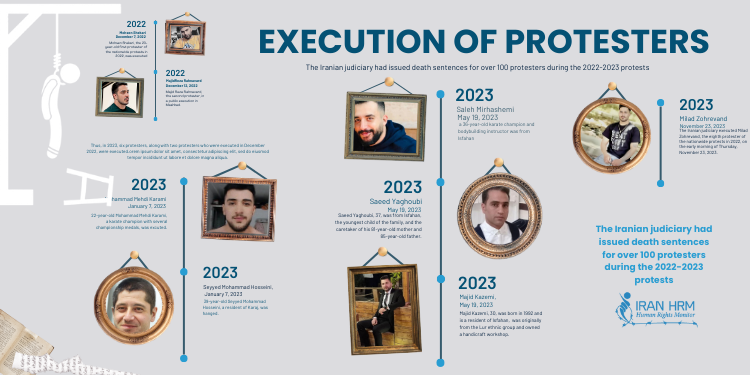
• The Iranian regime executed Mohsen Shekari, the 23-year-old protester who participated in the nationwide protests in 2022. They hastily executed him on December 7, 2022, without any proper legal procedure.
• Four days later, on December 12, 2022, the Iranian judiciary executed Majid Reza Rahnavard, the second protester, in a public execution in Mashhad. Majid Reza was arrested on November 19, 2022, and executed just 21 days later after a hasty judicial process.
• Just seven days into the year 2023, the Iranian judiciary executed the third and fourth protesters of the nationwide protests in 2022 without informing their families. There was no media coverage. On the early morning of January 7, 2023, the death sentence of the 22-year-old Mohammad Mehdi Karami, a karate champion with several championship medals, was carried out. Alongside him, the 39-year-old Seyyed Mohammad Hosseini, from Karaj, was also executed. They were the first and second defendants in the case of the murder of a Basij member. Mohammad Mehdi Karami was on a hunger strike when he was hanged.
• On the early morning of May 19, 2023, the Iranian judiciary executed three protesters accused in the case of “Isfahan House.” Saleh Mir Hashemi, a 36-year-old karate champion and bodybuilding instructor was from Isfahan. Majid Kazemi, 30, was born in 1992 in Isfahan. He was originally from the Lor ethnic group and owned a handicraft workshop. Saeed Yaghoubi, 37, was from Isfahan. He was the youngest child of the family, and the caretaker of his 81-year-old mother and 85-year-old father. The three protesters were arrested during the nationwide protests in Isfahan on November 21, 2022. They were severely tortured and forced to make false confessions. Based on these coerced confessions, all three individuals were sentenced to death.
• The Iranian judiciary executed Milad Zohrevand, the eighth protester of the nationwide protests in 2022, on the early morning of Thursday, November 23, 2023. Milad Zohrevand, was secretly executed in the central prison of Hamedan, under the fabricated charge of “killing an intelligence officer of the Islamic Revolutionary Guard Corps (IRGC)” during the nationwide protests in 2022.
Six protesters were executed in 2023 and two in December 2022. The eight protesters were sentenced to death and hanged after unfair trials, solely for their participation in the protests.
In the meantime, the Iranian judiciary continues to uphold the death sentences of protesters, and recently it has upheld the death sentences of Mojahed Kourkouri and Reza Rasaei. We might hear the news of their secret executions any time, soon.
The Iranian judiciary had issued death sentences for over 100 protesters during the 2022-2023 protests. Some of the protesters are still in a state of uncertainty, while others remain under the shadow of the death sentences. For instance, Saman Yasin has been subjected to artificial execution multiple times as a means of torture. He is enduring his imprisonment in a state of uncertainty.
Murder of protesters in prisons
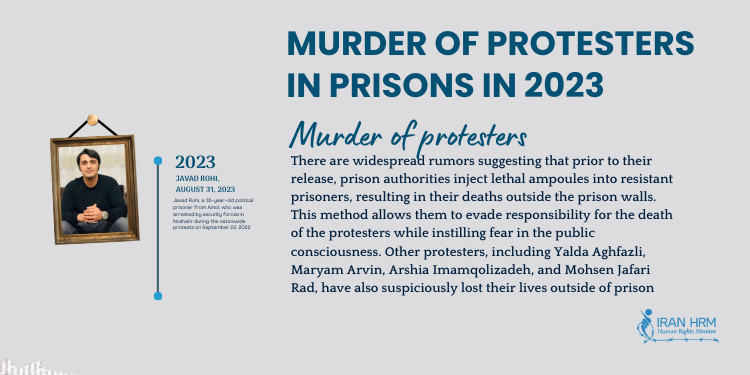
Javad Rouhi, a 35-year-old political prisoner from Amol, who was arrested by security forces in Nowshahr during the nationwide protests on September 22, 2022, had been sentenced to death twice by the Revolutionary Court in Sari. On Friday, August 31, 2023, in Nowshahr Prison, he passed away under highly suspicious and vague circumstances. Some sources have attributed his death to poisoning. There are unconfirmed reports that he has been murdered.
Local sources have also referred to the previous physical and psychological pressures and torture endured by Javad Rouhi. They have labeled his death as a state-sanctioned murder resulting from “poisoning.”
There are widespread rumors suggesting that prior to their release, prison authorities give lethal injections to resistant prisoners, resulting in their deaths outside the prison walls. This method allows them to evade responsibility for the death of the protesters while instilling fear among the public. Other protesters, including Yalda Aghafazli, Maryam Arvin, Arshia Imamqolizadeh, and Mohsen Jafari Rad, have also suspiciously lost their lives outside of prison.
It is not precisely clear whether prison authorities administer lethal drugs or inject them before the prisoners’ release, or if the individuals resort to suicide due to the torture they endure during detention.
Eye injuries inflicted on individuals
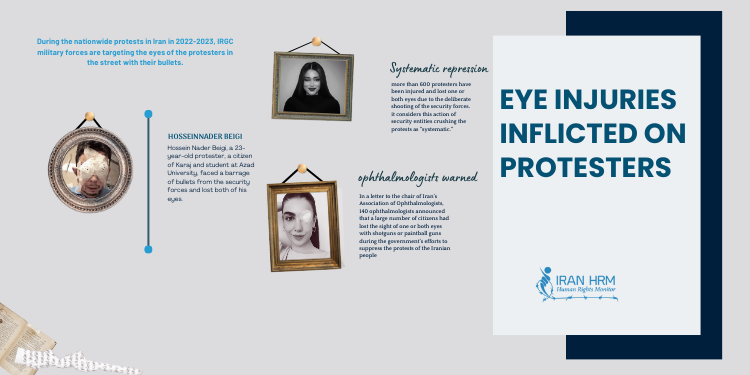
IRGC military forces targeted the eyes of the protesters in the street with their pellet guns during the nationwide protests in Iran in 2022-2023. More than 600 protesters have lost one or both eyes due to the deliberate shooting of the security forces.
Several months of research by Iran Human Rights Monitor (IranHRM) reveals the shootings to be a “systematic measure,” considering the volume of reports related to protesters being shot in the head and face by security forces, a significant number of whom have been blinded.
Additionally, on November 25, 2022, dozens of ophthalmologists warned about the blinding of protesters by government agents firing at them with pellet guns. In a letter to the chair of Iran’s Association of Ophthalmologists, 140 ophthalmologists announced that a large number of citizens had lost the sight of one or both eyes with shotguns.
Chain poisoning of girls’ schools
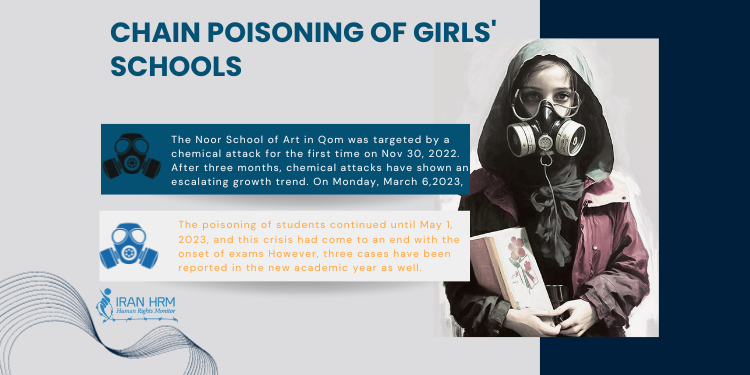
Government officials in Iran implemented one of their own crises by poisoning students, aiming to instill an atmosphere of fear and terror in society in order to suppress popular protests. The poisoning attacks were a way to punish the female student activists who had been at the forefront of the uprisings.
The Noor School of Art in Qom was targeted by a chemical attack for the first time on November 30, 2023. After three months, chemical attacks showed an escalating growth. On Monday, March 6, the attacks reached all parts of Iran, including many deprived areas that are hardly found on the map. In these small cities, there aren’t even respiratory resuscitation facilities available for the poisoned students.
The poisoning of students continued until May 1, 2023, and it seemed that this crisis had come to an end with the onset of exams and summer vacation. However, three cases have been reported in the new academic year as well.
• On October 7, 2023: Reports emerged of the poisoning of students at Ashura Girls’ School in the city of Qods, located in western Tehran province.
• On October 30, 2023: Sixty-seven students from Kowsar Girls’ High School in the city of Zanjan were hospitalized due to “poisoning.”
• On November 4, 2023: Dozens of students from Kowsar School in Ahvaz were transferred to the hospital with symptoms of poisoning.
Use of combined gases!! Ordinary individuals do not have access to these gases
In an interview with a local newspaper, Mohammad Reza Hashemian, a specialist in the intensive care unit (ICU) of Masih Daneshvari Hospital, stated on March 5, 2023, “The gas released is N2, or nitrogen, or N2O, which is an anesthesia gas. Some students reported smelling the odor of eggs when the gas was released, which is typical of gases containing sulfur. In recent days, students have also reported the smell of rotten tangerines or bleach. Each of these smells indicates a particular type of gas. But what appears to be the case is that in these incidents, combined gases are being used for poisoning, and they are being used in a very smart way.”
He emphasized that access to these gases is impossible for ordinary people. Although some gases are used for anesthesia or laparoscopy, they are not readily available to the public.
According to his statement, some reports indicate that some individuals have experienced muscle numbness or temporary paralysis. In any case, the issue is severe and can lead to even more severe consequences, such as kidney and lung problems.
Violent treatment of poisoned students by security agents
It is likely that government authorities in Iran have given specific instructions to all principals in Iran’s schools on how to deal with gas attacks in schools, as similar behavior has been observed among most of the principals. They have prevented the notification and arrival of emergency services and put students’ safety at risk.
Armita Gravand a victim of state murder in Iran

The government forces, in order to suppress nationwide protests and spread fear and terror, had already employed 400 personnel from the City Council Protection Unit, known as “Hijab Guards,” in the Tehran metro. The duty of these oppressive forces was to verbally reprimand and prevent unveiled individuals from entering the metro. Armita Gravand became a victim of this same dirty policy of the Iranian regime to confront women and girls in Iran.
On Sunday, October 1, 2023, a 17-year-old female student named Armita Gravand, a resident of Tehran, was subjected to physical assault by security forces in Tehran’s Shohada Metro Station, under the pretext of improper veiling. The intensity of the beatings was so severe that the student fell into a coma and was subsequently transferred to the hospital. Finally, after 28 days, while this teenage girl was in a coma, Armita Gravand, passed away at Fajr Hospital of the Tehran Air Force, on Saturday, October 28, 2023.
Eyewitnesses revealed the details of the Armita Gravand incident
An eyewitness told the Guardian: “A female veil watcher attendant had an argument with Armita Gravand when she entered the subway car, over not wearing a hijab.” According to him: “The veiled woman shouted: Why don’t you wear a hijab?”
Armita responded, “Am I telling you why you don’t wear a headscarf?” Then their argument escalated into violence, and the female veil watcher attacked Armita, severely pushing her. Another witness stated, “Armita was conscious even when she fell to the ground.” This eyewitness said, “The same woman who pushed Armita was standing behind the door of the ambulance that took her to the hospital”.
According to the reports received by Iran Human Rights Monitor (IranHRM), Armita Gravand was born on April 2, 2006, in Kermanshah and lived in Tehran. On October 1, 2023, she was subjected to assault by Hijab patrols solely because she was not wearing a headscarf, which led to her falling into a coma. She lost her life after 28 days.
Call on International Human Rights Authorities
In the end of its annual report, the Iran Human Rights Monitor (Iran HRM) calls upon the international community, particularly the United Nations and all human rights advocates, to condemn the execution of protesters in Iran and take immediate action to halt the implementation of death sentences in the country.
Iran Human Rights Monitor (Iran HRM) also calls for an end to violence against women in Iran and demands independent international investigations into the case of Armita Gravand.
Iran Human Rights Monitor (Iran HRM) calls on the Independent International Fact-Finding Mission on Iran to visit both public and secret prisons of the Iranian regime, particularly the prisons of the Ministry of Intelligence and law enforcement forces. It also demands the release of all detainees arrested during the 2022 protests.
 Shabtabnews In this dark night, I have lost my way – Arise from a corner, oh you the star of guidance.
Shabtabnews In this dark night, I have lost my way – Arise from a corner, oh you the star of guidance.



